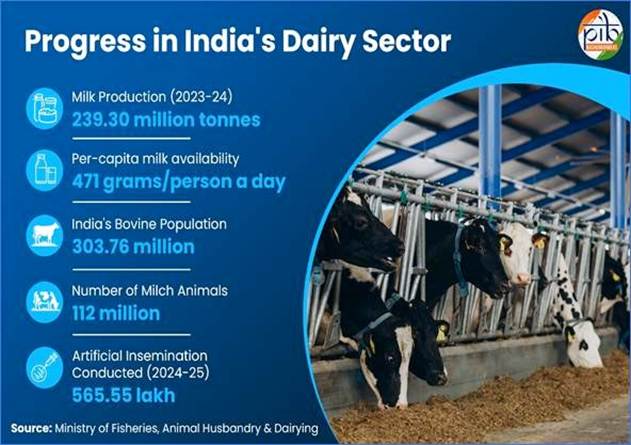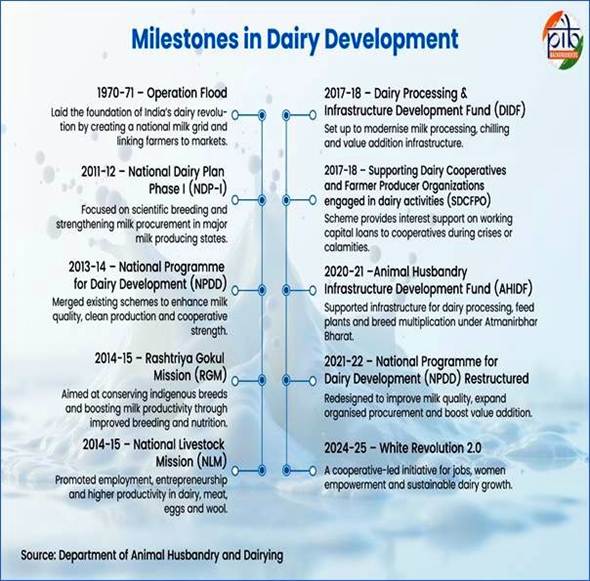Content
- Hamara Samvidhan- Hamara Swabhiman Campaign
- National Milk Day
Hamara Samvidhan- Hamara Swabhiman Campaign
Why in News?
- Government launched the next phase of its nationwide constitutional outreach: “Hamara Samvidhan – Hamara Swabhiman” on 24 Jan 2025, building on the year-long 2024–25 “Hamara Samvidhan – Hamara Samman” campaign.
- Part of DISHA Scheme (2021–26); aims to deepen constitutional literacy, legal empowerment, and citizen engagement.
- Reported 1+ crore citizens, 13,700+ events, and outreach to 2.5 lakh Gram Panchayats.
Relevance
GS2 – Governance, Polity, Social Justice
- Constitutional values dissemination
- Access to justice architecture
- Legal empowerment of marginalised groups
- Role of digital governance (MyGov, Tele-Law)
26 November – Constitution Day (Samvidhan Diwas)
- Marks adoption of the Constitution on 26 Nov 1949; came into force on 26 Jan 1950.
- Instituted in 2015 to promote constitutional literacy, duties, values.
- Celebrated nationwide through Preamble reading, legal awareness drives, school programmes, and MyGov campaigns.
- Reinforces core ideals: justice, liberty, equality, fraternity, constitutional morality, and democratic citizenship.
- 75th Constitution Day (2024–25) – 75 Years of Adoption
Basics
Purpose
- Create mass awareness of Constitution & legal rights.
- Strengthen last-mile access to justice via DISHA (Tele-Law, Nyaya Bandhu, legal literacy).
- Instill pride, duty consciousness, constitutional nationalism.
Timeline
- 24 Jan 2024: Launch of Hamara Samvidhan – Hamara Samman.
- 24 Jan 2025: Transition to Hamara Samvidhan – Hamara Swabhiman.
Associated Scheme
- DISHA (2021–26): National legal empowerment framework
- Tele-Law
- Nyaya Bandhu (Pro Bono)
- Legal Literacy & Awareness Programmes
Objectives
- Create permanent public memory markers for the Constitution.
- Deepen legal-literacy, especially among marginalised groups.
- Highlight Constituent Assembly’s work.
- Promote Panch Pran values.
- Build pride in India’s constitutional journey towards Viksit Bharat 2047.
Major Components of the Campaign
A.Sabko Nyay – Har Ghar Nyaya
Aim: Grassroots access to justice.
Key Elements
- Panch Pran Pledge
- Development-first mindset
- Removal of servile mentality
- Pride in heritage
- Unity & integrity
- Duty consciousness
- Nyaya Seva Mela
- Held in 25 States/UTs
- Tele-Law books, Voice of Beneficiaries editions, field functionaries’ felicitation
- Reached 84.6 lakh+ citizens
- Nyaya Sahayak Model
- Community legal messengers
- 14,598+ cases registered
- Vidhi Baithaks at village/block level
- Participation: Anganwadi, SHGs, SMCs, Panchayats
B. Nav Bharat Nav Sankalp
Aim: Youth engagement via MyGov.
Activities: Pledge-taking, quizzes, contests, idea generation linked to Panch Pran & Constitution.
C. Vidhi Jagriti Abhiyaan
Aim: Deepening legal awareness among rural & marginalised communities.
Key Initiatives
- Gram Vidhi Chetna
- Student-led village legal literacy events
- 10,000+ beneficiaries
- Vanchit Varg Samman Abhiyaan
- With IGNOU & Doordarshan
- Legal protections for: children, women, SCs, PwDs, transgender community, senior citizens
- Nari Bhagidari
- Gender rights webinars & village-level programmes (NLSIU, NLU, VIPS etc.)
- Focus on crimes against women, social protections
Impact
- 1 crore+ citizens reached
- 13,700+ nationwide events
- 2.5 lakh+ Gram Panchayats involved
- 14,598+ cases supported via Nyaya Sahayaks
- 84.6 lakh+ digital outreach through Tele-Law awareness
- 10,000+ direct beneficiaries in Gram Vidhi Chetna
- Massive youth engagement through MyGov pledges/quizzes
Analytical Assessment
Strengths
- Largest constitutional outreach ever undertaken in India.
- Bridges gap between legal awareness & actual legal access.
- Digital + grassroots hybrid model ensures inclusivity.
- Constitutes a behavioural-change campaign—pride, duties, civic values.
- Strong alignment with Viksit Bharat 2047 narrative and citizen-state partnership.
Challenges
- Sustaining momentum beyond campaign cycles.
- Need for institutionalisation at school/university level.
- Digital divide may limit remote-area engagement.
- Measuring quality of legal empowerment, not just participation.
Opportunities
- Can evolve into a permanent constitutional literacy mission.
- Integration with NEP 2020 modules: civic education, legal literacy.
- Scale-up of Tele-Law/Pro Bono ecosystems.
- Building grassroots constitutional culture akin to civic republicanism models (US, EU).
Conclusion
- Demonstrated India’s largest-ever constitutional outreach, embedding constitutional literacy from grassroots to digital platforms.
- Shifted public engagement from mere awareness to active participation, legal empowerment, and constitutional pride.
National Milk Day
Why is it in News?
- Observed annually on 26 November; 2025 marks National Milk Day with major policy pushes in dairy (GST reform, White Revolution 2.0).
- PIB (25 Nov 2025) released a comprehensive status report on India’s dairy sector.
- Announcement of Gopal Ratna Awards 2025; new infrastructure and cooperative expansions highlighted.
Relevance
GS3 – Economy / Agriculture
- Dairy as a 5% of GDP contributor; core to rural livelihoods and agri-value chains.
- Policy interventions: GST reform (2025), White Revolution 2.0, NPDD, RGM → productivity, processing capacity, cooperative strengthening.
- Importance for food security, nutrition, women-led growth, and export potential.
GS2 – Governance / Welfare Delivery
- Cooperative federalism via NDDB, State Federations, MPOs; expansion of doorstep breeding, veterinary, AI services.
- Inclusion of women (70% workforce) and marginal farmers through targeted schemes.
- Institutional strengthening: digital databases, village labs, MAITRIs, disease eradication roadmap.
Basics
- Celebrated on birth anniversary of Dr. Verghese Kurien, architect of India’s White Revolution.
- Purpose: honour dairy farmers, strengthen cooperative spirit, spread awareness on nutrition and dairy-led livelihoods.
- India is the world’s largest milk producer (≈25% of global supply), contributing ~5% of GDP; 8 crore farmers engaged.

India’s Dairy Significance
- Essential source of protein, calcium, micronutrients; near-complete food.
- Dairy = backbone of rural economy, especially for small/marginal farmers.
- 70% of dairy workforce are women, making it a major gender-inclusive sector.

Historical Evolution
- 1950s–60s: Low productivity, milk deficit, import-dependent; production CAGR collapsed to 1.15%.
- Anand/Amul model under Sardar Patel, Tribhuvandas Patel → foundation of cooperative success.
- NDDB (1965) under Kurien → mission to replicate the cooperative model nationally.
- Operation Flood (1970–96): transformed India into a milk-surplus nation; NDDB declared Institution of National Importance (1987).
Decadal Performance (2014–2025)
- Milk output rose from 146.3 MT (2014-15) → 239.3 MT (2023-24) (63.56% rise).
- Per-capita availability jumped 124 g/day → 471 g/day.
- Bovine population: 303.76 million; productivity up 27.39% (global avg. 13.97%).
- Indigenous breeds’ milk: 29 MT → 50 MT.
- Rise in milch animals: 86 million → 112 million.
Key Drivers of Growth
- Rashtriya Gokul Mission (RGM)
- Budget raised to ₹3,400 crore (2021–26 cycle).
- Focus on genetic improvement, semen stations, sex-sorted semen.
- 92 million animals covered, benefitting 56 million farmers.
- Artificial Insemination & NAIP
- Coverage still low (33% of breedable bovines).
- 14.12 crore inseminations, 9.16 crore animals reached.
- 22 IVF labs, 1 crore+ sex-sorted semen doses.
- MAITRIs
- 38,736 technicians deployed; doorstep breeding/veterinary services.
- Progeny Testing
- 3,747 bulls tested; 132 breed multiplication farms approved.
National Programme for Dairy Development (NPDD)
- Strengthens procurement, processing, chilling, marketing.
- 31,908 dairy cooperatives organised/revived.
- 17.63 lakh new producers added; procurement up by 120.68 lakh kg/day.
- 61,677 village labs, ~6,000 bulk coolers, 279 plant labs upgraded.
- Large new plants: Mehsana, Indore, Bhilwara, Karimnagar; Chittoor (₹219 crore).
Cooperative Dairy Ecosystem
- 22 federations, 241 unions, 25 MPOs; coverage: 2.35 lakh villages, 1.72 crore farmers.
- Women: 70% workforce, 35% cooperative membership; 48,000 women-led cooperatives, 16 all-women MPOs.
- Shreeja MPO (AP) → global award recognition.
GST Reforms (56th GST Council, 2025)
- Effective 22 Sep 2025.
- UHT milk & packaged paneer → GST 0%.
- Butter, ghee, cheese, condensed milk, milk beverages → 12% → 5%.
- Ice cream 18% → 5%.
- Milk cans 12% → 5%.
- Impact: lowers cost, boosts demand, strengthens supply chain, benefits 8 crore rural households.
White Revolution 2.0 (2024–29)
- 75,000 new cooperatives to be created; 46,422 existing strengthened.
- Focus on: procurement expansion (target 1007 lakh kg/day), women’s participation, sustainability.
- Creation of three MSCS for feed, organic manure/circular economy, and animal by-product management.
Infrastructure Expansion
- Sabar Dairy Plant, Rohtak (₹350 cr)
- India’s largest plant for curd, buttermilk, yoghurt.
- Supports NCR demand; empowers farmers across 9 states.
Future Outlook (2025–30)
- India to supply 32% of global milk (2025-26).
- Milk output projected: 242 MT (2026).
- Cattle population share rising 35% → 36%.
- Processing capacity target: 100 million litres/day by 2028–29.
- FMD & Brucellosis eradication by 2030 through free vaccines.
- Pashudhan digital database for precise planning.
- Export potential expected to rise significantly.
Recognition and Awards
- National Gopal Ratna Awards 2025 announced.
- Categories: Best farmers (indigenous), best cooperatives/MPOs, best AI technicians.
- Prizes: ₹5 lakh / ₹3 lakh / ₹2 lakh.
Conclusion
- India’s dairy sector has evolved from scarcity to global leadership through cooperative strength, scientific breeding, and sustained reforms.
- National Milk Day 2025 reflects this transformation—rising productivity, strengthened infrastructure, women-led expansion, and wide-ranging fiscal reforms.
- The next phase (White Revolution 2.0) aims to elevate India from being the largest producer to becoming a major global dairy exporter, ensuring inclusive, resilient, and sustainable rural growth.



